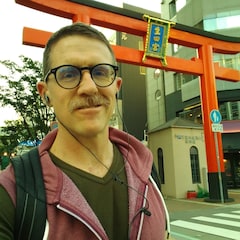Matsuyama Treasures: Historical Hot Springs and a Mountaintop Castle
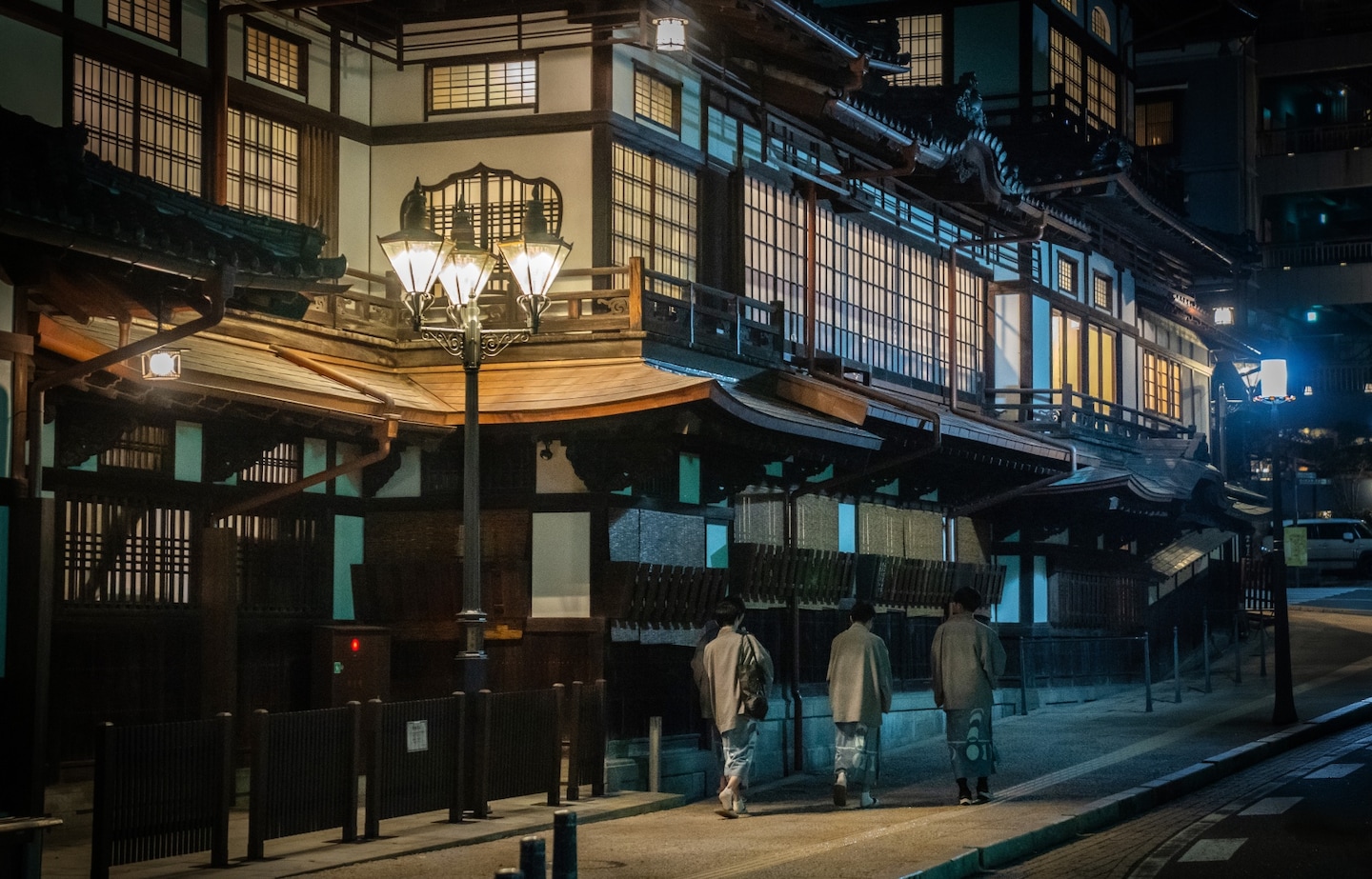
Japan's oldest hotspring, Dogo Onsen, has reopened after a 5 1/2-year restoration.
The town of Matsuyama, on the island of Shikoku, is a gem for the adventurous traveler. It hosts one of Japan's most photogenic castle keeps and a newly restored traditional onsen bathhouse with a rich historical heritage.
All photos by Cindy Bissig
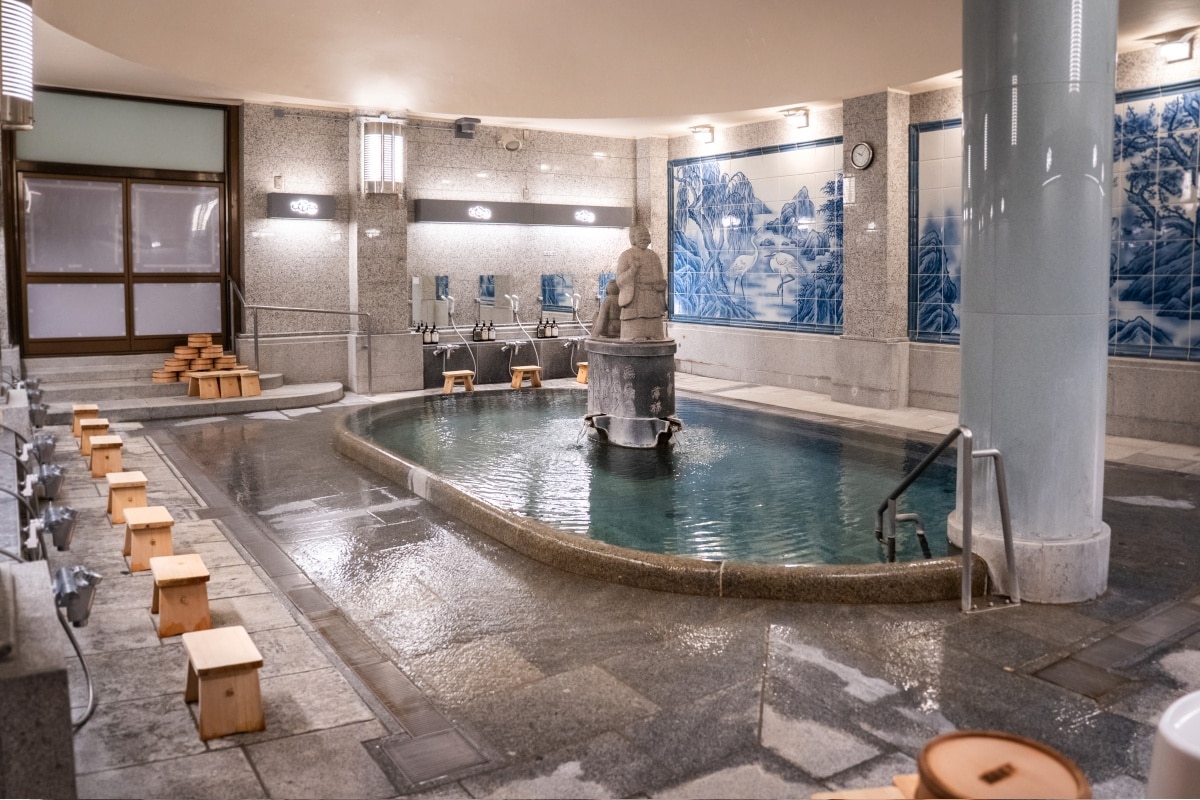
The Tama-no-yu bath for women features beautifully tiled walls.
I love hot springs. This was not always the case—my upbringing was a tad prudish, and naked communal bathing took some getting used to. During my first year in Japan on a working holiday, I was frequently invited to public baths and onsen (hot spring) getaways by friends and work colleagues, and soon realized how refreshing and relaxing they are, in company or alone. Later, I took full advantage of my 10 years spent in Odawara, just 30 minutes from Hakone, one of Japan’s best-known hot spring towns, before I settled in Kobe in 2016.
A couple of years ago, in the midst of typhoon season, my partner and I decided on a trip to Dogo Onsen bathhouse, one of Japan’s oldest and most famous hot springs, in the city of Matsuyama on the island of Shikoku. We rented a car and braved the heavy rains, only to find the venerable old building mostly dark, and surrounded by scaffolding. Though disappointed, one section of the baths was still operating, so our drive across the island through the storm was not in vain.
When I heard that Dogo Onsen had reopened, I was determined to go again. I wanted to experience more of Matsuyama, a city that still feels like a well-guarded secret, just as Shikoku is considered by some to be an isolated backwater. (When I mentioned my plans, a colleague moaned, “Matsuyama’s too far.”) But in ancient times, the Seto Inland Sea was the heart of maritime transport, and the island was well-connected with Honshu and Kyushu islands.
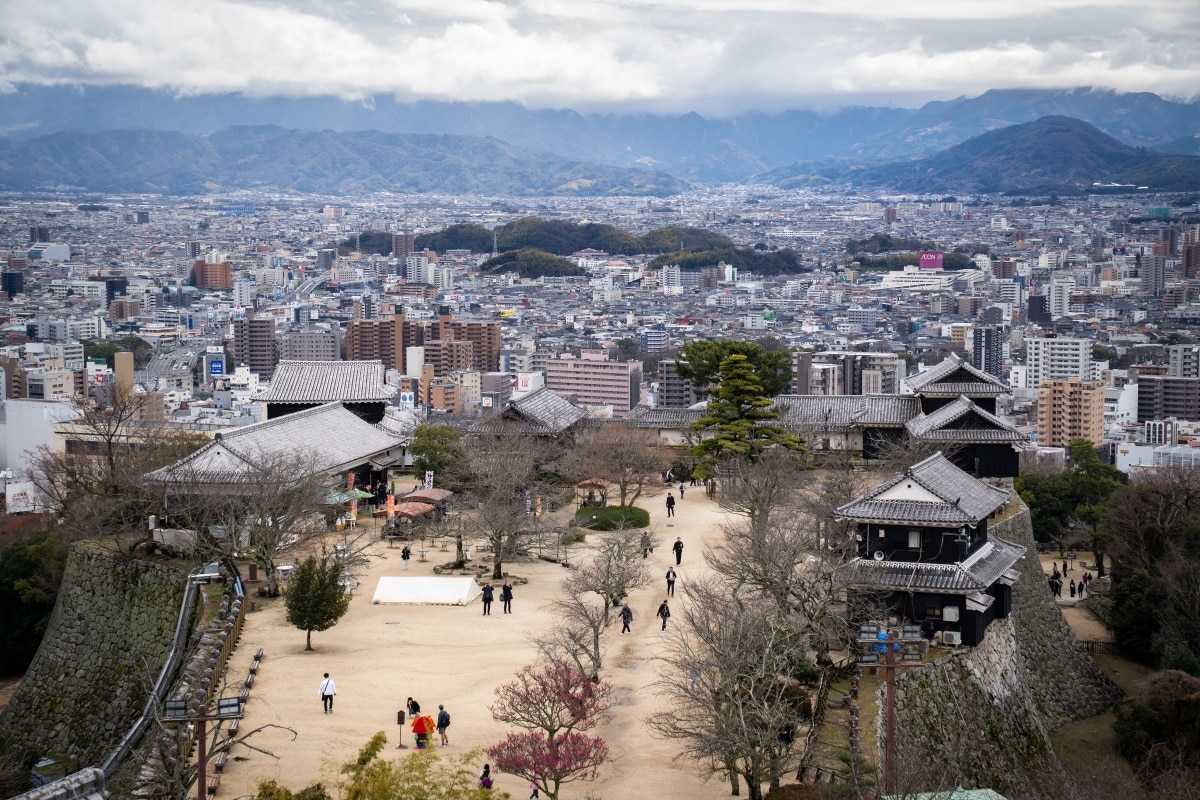
A panoramic view of the city from the honmaru, Matsuyama Castle's uppermost fortification.
Commerce helped Matsuyama grow into a major castle town, ranked in the top 30 wealthiest of the more than two hundred feudal domains. Although it was heavily bombed in the war, the city was rebuilt into a modern, convenient community that is Shikoku’s biggest (population 500,000+). As far as access goes? Well, getting there is half the fun: I’ve taken an express train from Honshu; I’ve used slower trains and boats; this time I chose long-distance bus, which was easier and more comfortable than I expected. I also discovered there’s now a high-speed ferry connecting Matsuyama with Hiroshima in 70 mins, which is very tempting—the Inland Sea with its many islands is dreamy. There are also regular flights connecting Matsuyama to major cities across Japan.
Climbing the Castle: on Foot or Chair Lift

The main keep of Matsuyama Castle, is surrounded by ornamental plum and cherry blossom trees, which bloom in the spring.
And so I arrived at the base of Matsuyama Castle, dramatically perched above me on a 131-meter high mountaintop, and visible from just about anywhere the city. It retains the original keep, and is one of twelve castles in Japan to have survived the Meiji government’s order to demolish the old castles just as it dismantled the old feudal system. Compared with Odawara or Himeji castles, two other highly regarded structures, Matsuyama Castle’s mountaintop setting imparts an otherworldly vibe. It must have been a superb defensive military location, offering spectacular views of the city, surrounding mountains, and the sea.
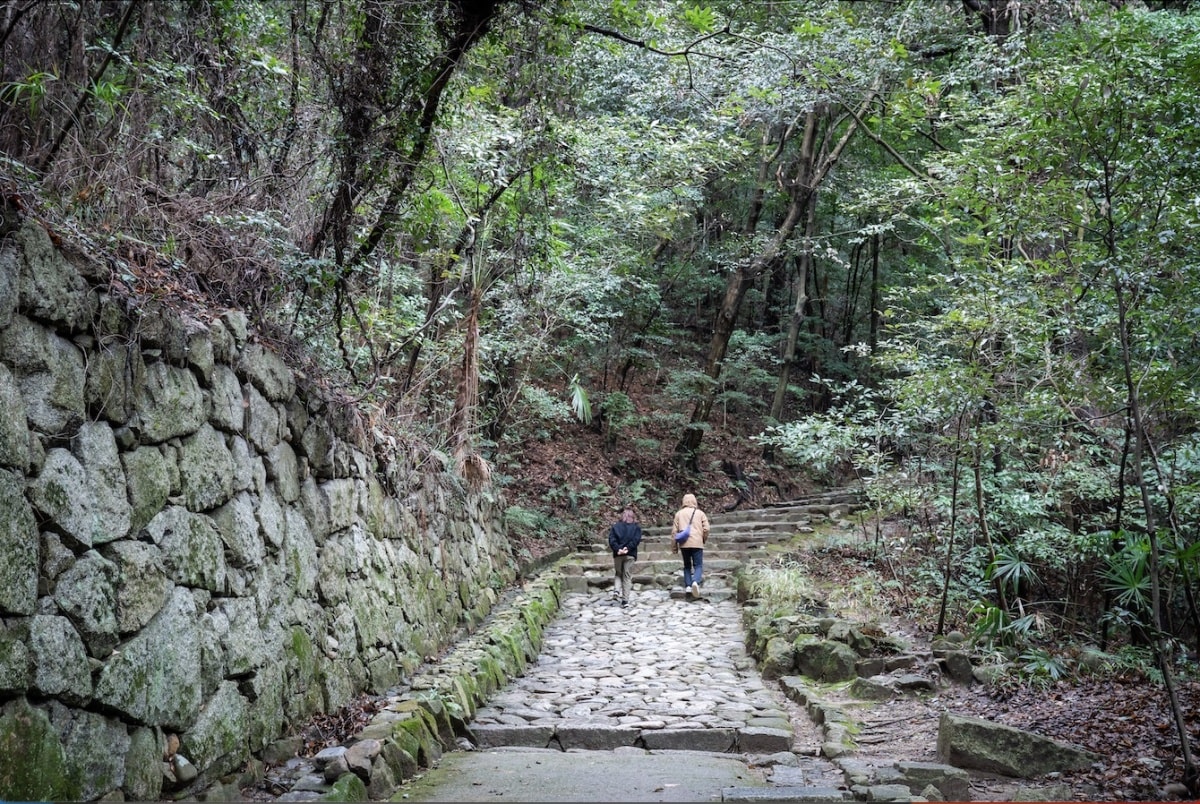
The cobblestone ascent to Matsuyama Castle on the Kuromon route is one of four routes up the mountain.
There are four pathways up the mountain through the dense forest—all moderately steep. One is the old Kuromon route, which starts from Horinouchi Park, an area within the outer moat that originally housed high-ranking vassals and administrative buildings before being demolished in the Meiji era to create a public park. I decided instead to approach from the east side. There, a cable car and chairlift (same price, different experience!) shortens the climb (there’s still a 10-minute walk at the end), but I chose the hard way: a half-hour climb up the Shinonome path. The hike wasn’t easy, but it was a good workout, and gave me a better appreciation of the castle’s majesty and impregnability.
Still Standing After Five Centuries

The approach to the main keep passes through multiple formidable portals, designed to stymy invaders.
Construction of Matsuyama Castle began in 1602 by the local lord Kato Yoshiaki, one of the powerful warlord Toyotomi Hideyoshi’s most trusted generals. Even before the castle was completed, however, he was transferred to distant Aizu in 1627, as he became the first of several lords entrusted with ruling the area. He was followed by Gamo Tadatomo, who tragically passed away in 1634. The following year, the shogunate installed Matsudaira Sadayuki—nephew of Ieyasu, the first Tokugawa shogun—as daimyo, and this family continued to govern the domain until the Meiji Restoration. Although it was never attacked, thanks to the peace that followed Tokugawa’s iron-fisted unification of Japan, the castle suffered numerous fires over the centuries, requiring the rebuilding of various structures.
As with most Japanese castles, Matsuyama castle’s keep was not built or used as a residence, but rather as a storehouse for treasure and weapons, as a stronghold in case of attack, and as a symbol of power. The lord, his family, and vassals lived in dwellings located within the grounds. In the case of Matsuyama Castle, Ninomaru Historic Site Garden, part way up the Kuromon path, garden and water features have been used to recreate the layout of the buildings and rooms, and an excavated well gives an idea of the scale of castle business.
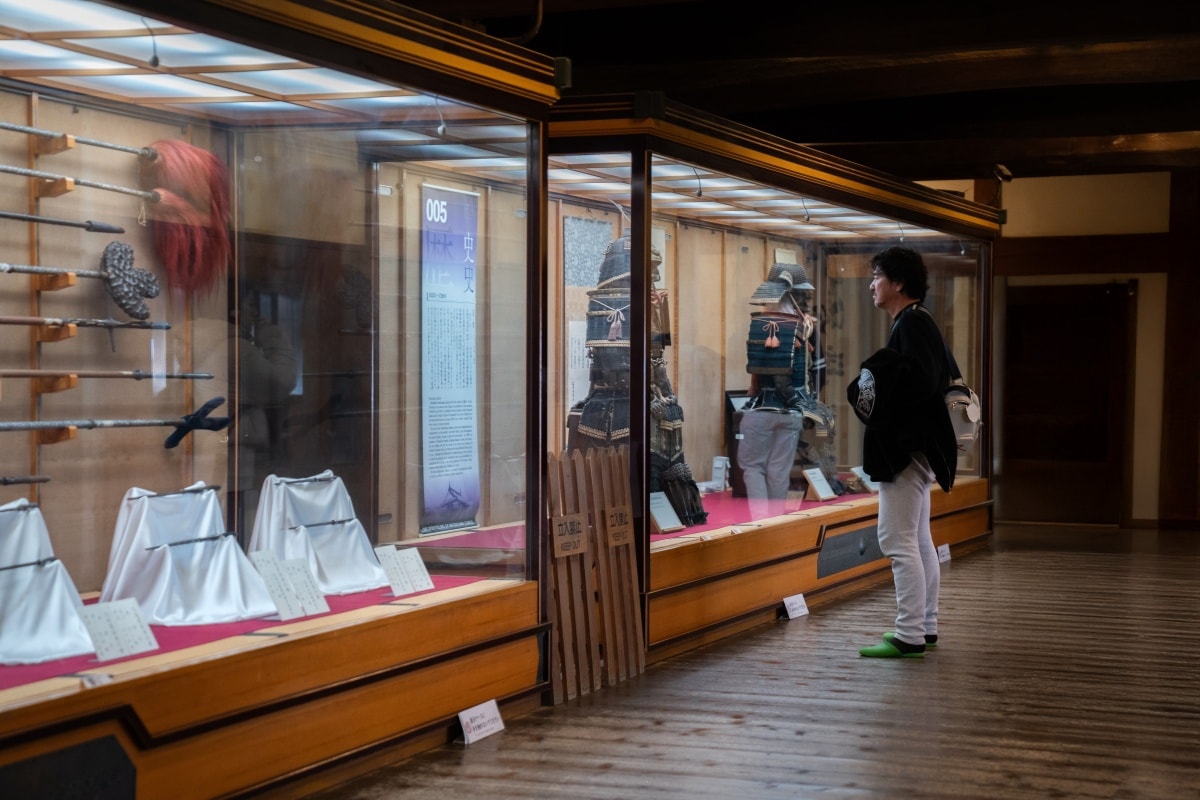
Historical displays provide insights into Edo period Japan's samurai culture and castle construction
The area called Sannomaru, at the southwestern base of the castle perimeter, is surrounded by a protective moat, which extended even further in feudal times. This was the hub of clan affairs, with the lord’s palace, dwellings of high-ranked vassals, and administrative facilities. I found a 17th century map with the names of castle residents and others in the immediate vicinity. Interestingly, each lists two names—one in red, indicating the resident during the reign of Lord Gamo, and another in black for those in Matsudaira’s time. This was common for castle towns across Japan— samurai lodgings were not permanent, and if the shogun installed a new feudal lord, their trusted retainers came with them.
Allow at least two hours to visit to the castle, including the ascent and descent—longer to fully appreciate the historical exhibit, Ninomaru gardens, or to stop for refreshments. There is plenty of climbing, both up the hill and in the castle, and the grounds are extensive enough for a good walking workout. That gave me the perfect excuse to head for Dogo Onsen and the chance to relax in historic waters.
Dogo Onsen's Long, Memorable History
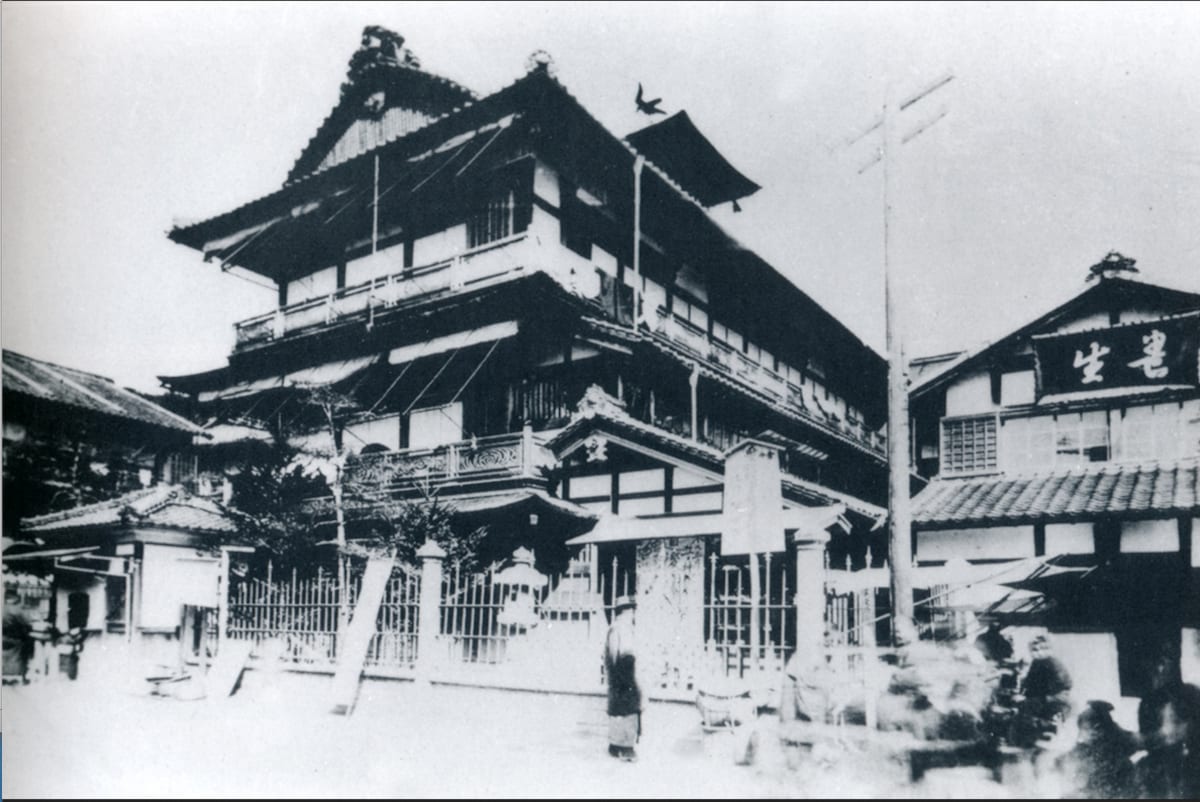
A photo of Dogo Onsen dated 1894.
Dogo’s hot springs have been popular since ancient times, having been mentioned in records dating back to the Asuka period (593–710), as well as in Murasaki Shikubu’s famous 11th century novel, The Tale of Genji. There is a connection with the castle as well. After Matsudaira Sadayuki became lord of the domain in 1635, he expanded Dogo’s facilities, establishing separate baths for samurai, priests, and commoners.
Dogo Onsen, the most recent incarnation of the hot springs dates back to the Meiji era, when the area’s first mayor decided the facilities should be renovated to create something that would “continue to be unrivaled even in 100 years.” Despite initial opposition from townsfolk, the three-story Kami-no-Yu wing of the now-famous Honkan, or main building, was completed in 1894. The mayor also successfully petitioned for the preservation of Matsuyama Castle, so he can be credited with saving Matsuyama’s two key tourist draws.
The Honkan was later expanded multiple times. The Yushinden/Tama-no-Yu wing was built in 1899, including the only exclusive bathing room for the Imperial Family at a hot spring. The South wing was completed in 1924, and the highly ornate Entrance wing was added in 1924. In 1994, Dogo Onsen Honkan was designated a National Important Cultural Property.
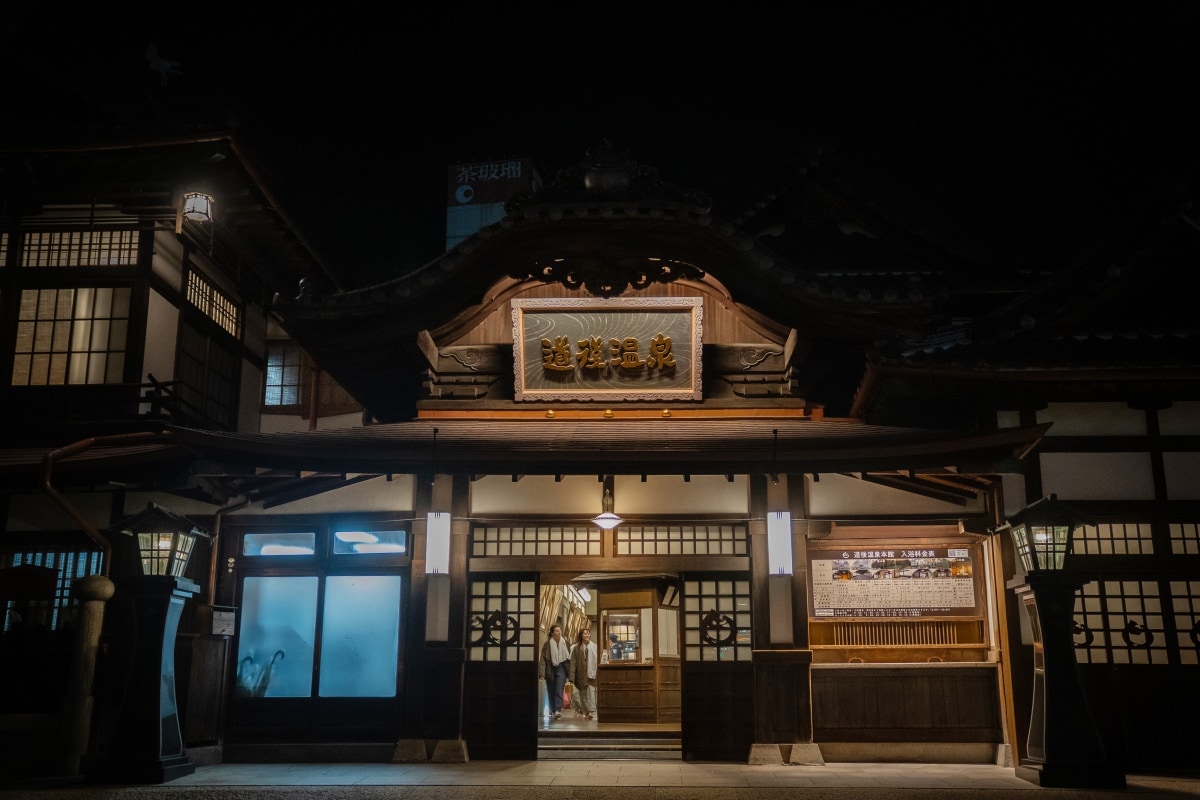
At night, Dogo Onsen takes on an otherworldly ambience.
Many years had passed since the Honkan's previous renovation, and therefore it was in desperate need of repair, not only from regular weathering but also from the highly humid internal environment. The difficult decision was made to undertake “once in a century” conservation work, dismantling and repairing the entire structure, requiring partial closure of Honkan. The facility fully reopened in July 2024.
Yamada Toyoki is a registered architect at the Matsuyama City Council who helped oversee the project. Due to the Honkan’s status as an Important Cultural Property, he says, repairs had to be as meticulous as those made during castle, temple or shrine restorations. That meant that, wherever possible, the original materials were reused and traditional techniques employed. “Initially, we estimated that the restoration would take 10 or 11 years,” he says. “But the economic importance of the facility for local businesses made us look for ways to reduce the time frame. We managed to cut the schedule to six years, and kept some sections operating throughout the restoration.”
The Inspiration for "Spirited Away"?
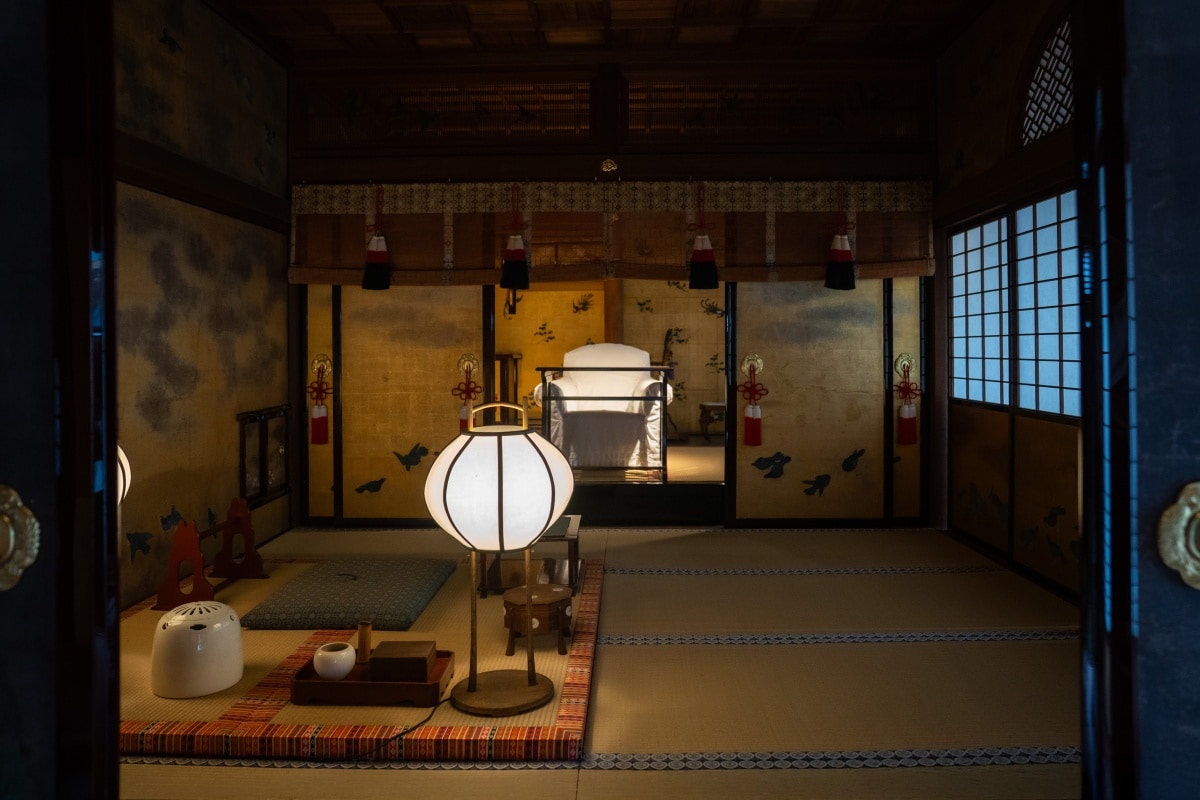
The ornate Yushinden, a section of the hotsprings reserved for exclusive use by the Imperial Household
The building was seismically reinforced, and one change fans quickly notice is the roof—the use of new copper has transformed the familiar mossy green into copper brown. “Some visitors initially complained that it was too shiny, but it has already dulled over time,” says Yamada. Apparently, though modern copper used is more durable, it too will eventually turn green. Many aspects of the restoration were “trial and error,” but the hope is that the extensive repair work will last for another 100 years.
The Tale of Genji is not the bath’s only artistic reference. On my previous visit, the scaffolding was hidden under an awning featuring giant, colorful murals by local artist Ohtake Shinro. Now that the scaffolding is gone, most anime fans would be struck by the similarity of the structure to the bathhouse in Miyazaki Hayao’s Ghibli film, Spirited Away. According to the architect Yamada, it is believed that Miyazaki and other colleagues visited the baths, and he said he believes they used the onsen as a reference for the anime..
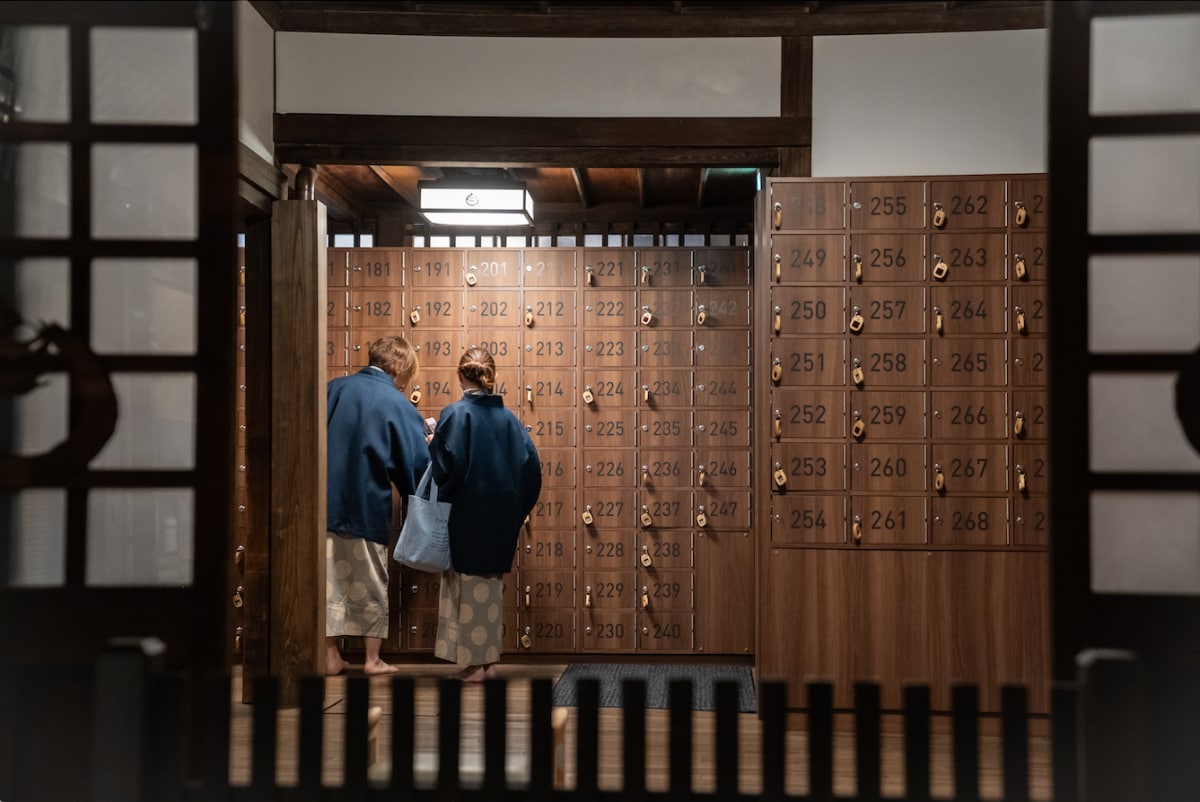
Footwear lockers. Yukata (bath robes) are perfect for relaxing after bathing.
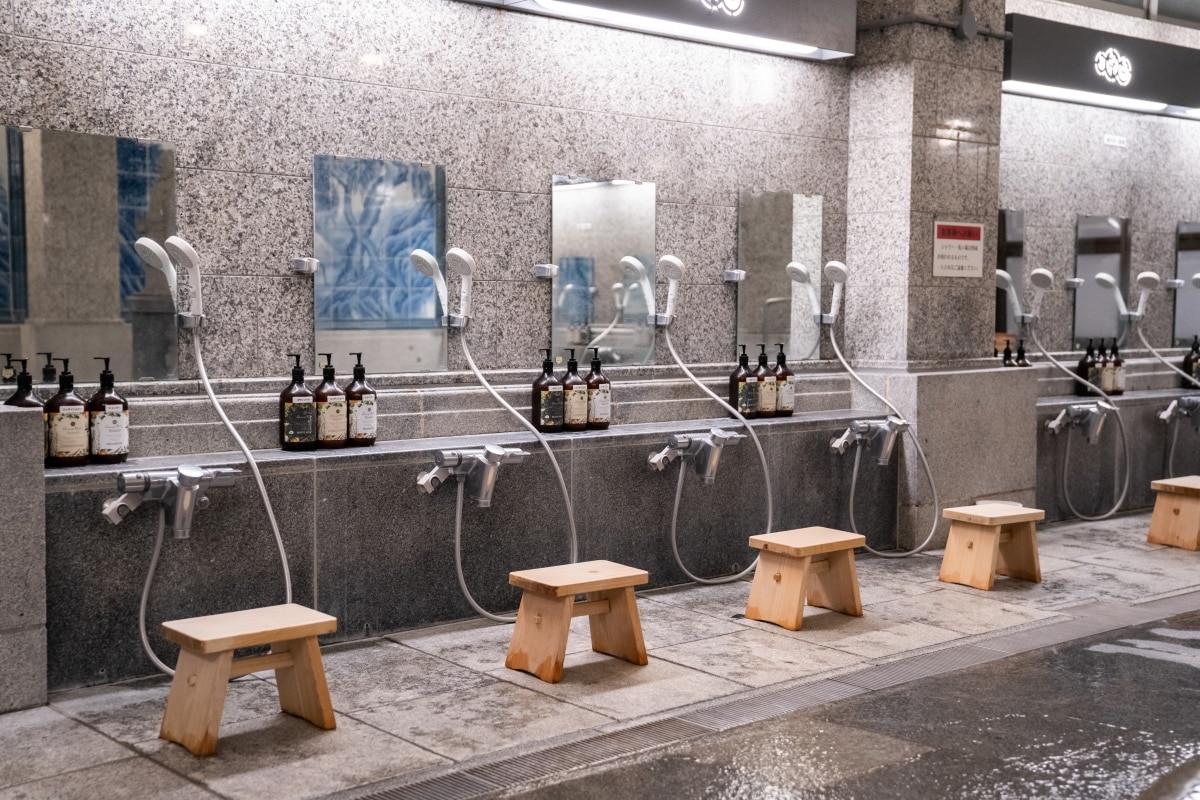
Seated area for showering before taking a bath. Shampoo, conditioner & body soap are provided.
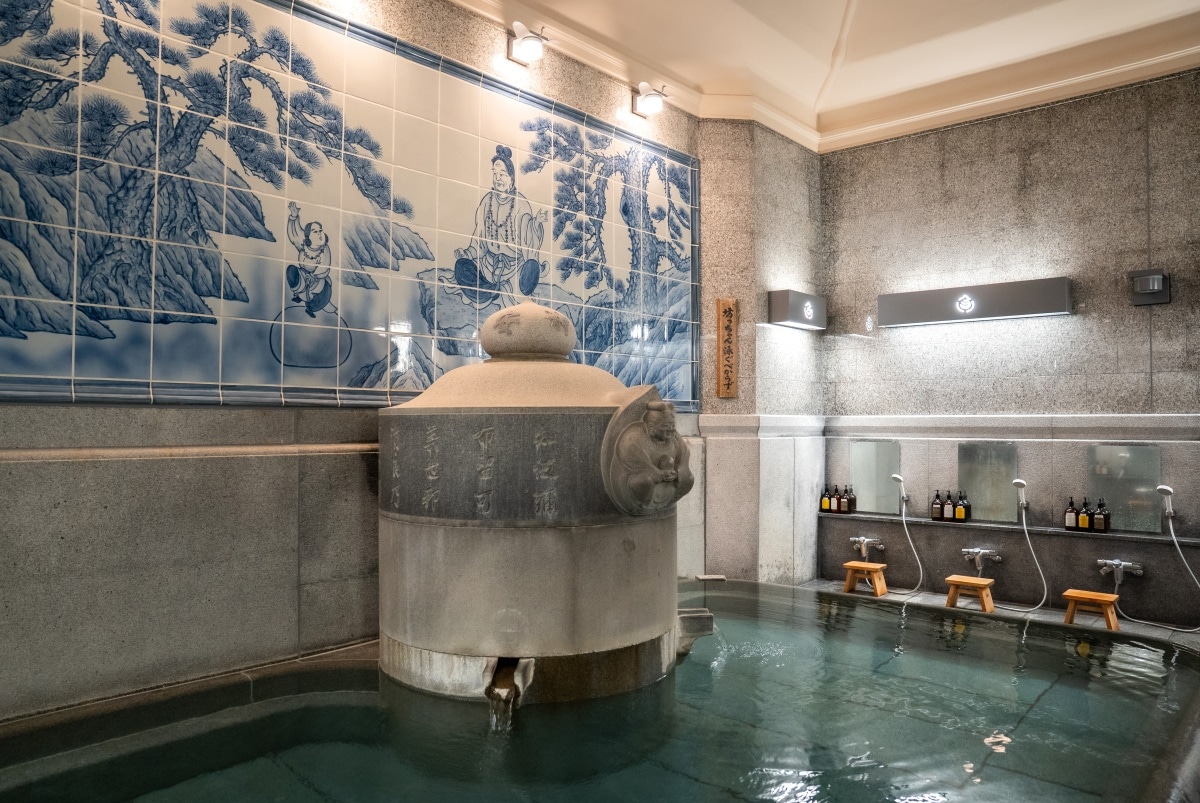
Kami-no-yu bath. The wooden plaque on the wall reads, “Botchan oyogubekarazu!” (Young master, do not swim here!).

Resting space on the 2nd floor. Private rooms are also available at extra cost.
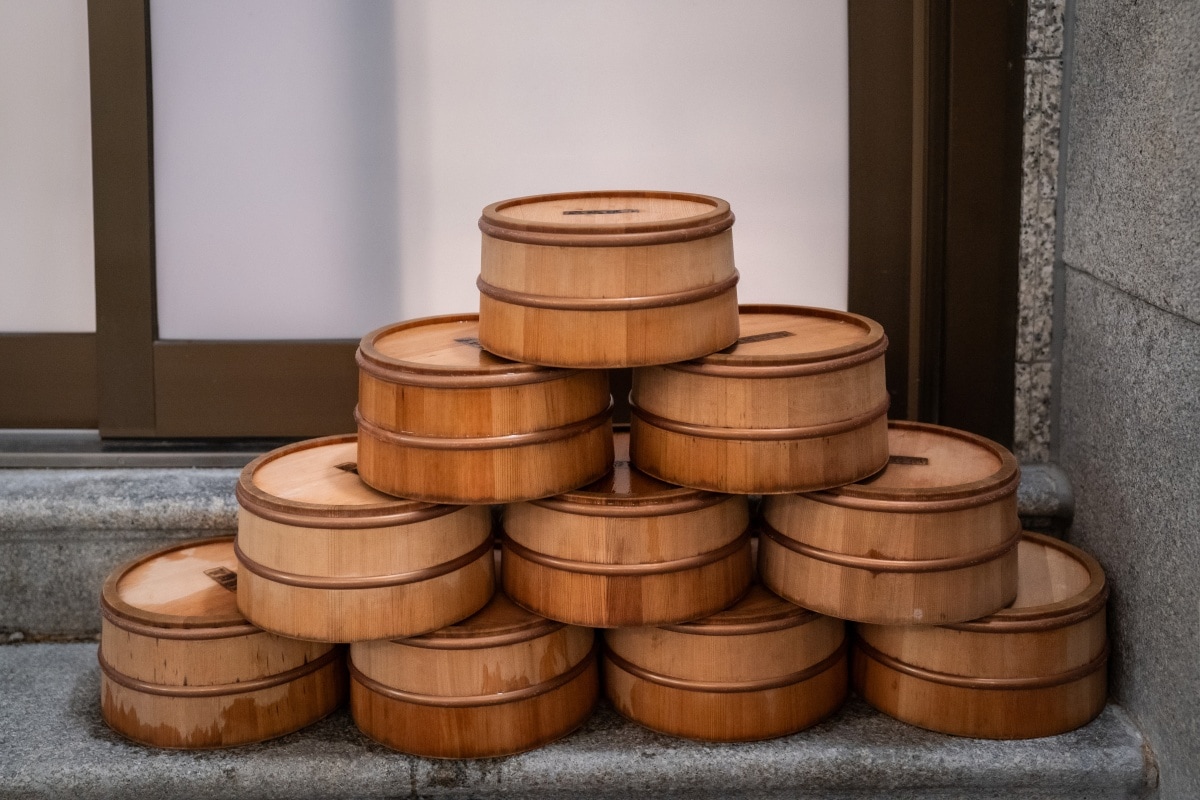
Oke, traditional buckets, are not just for show. They are an eco-friendly tool to save water when washing before taking a bath.
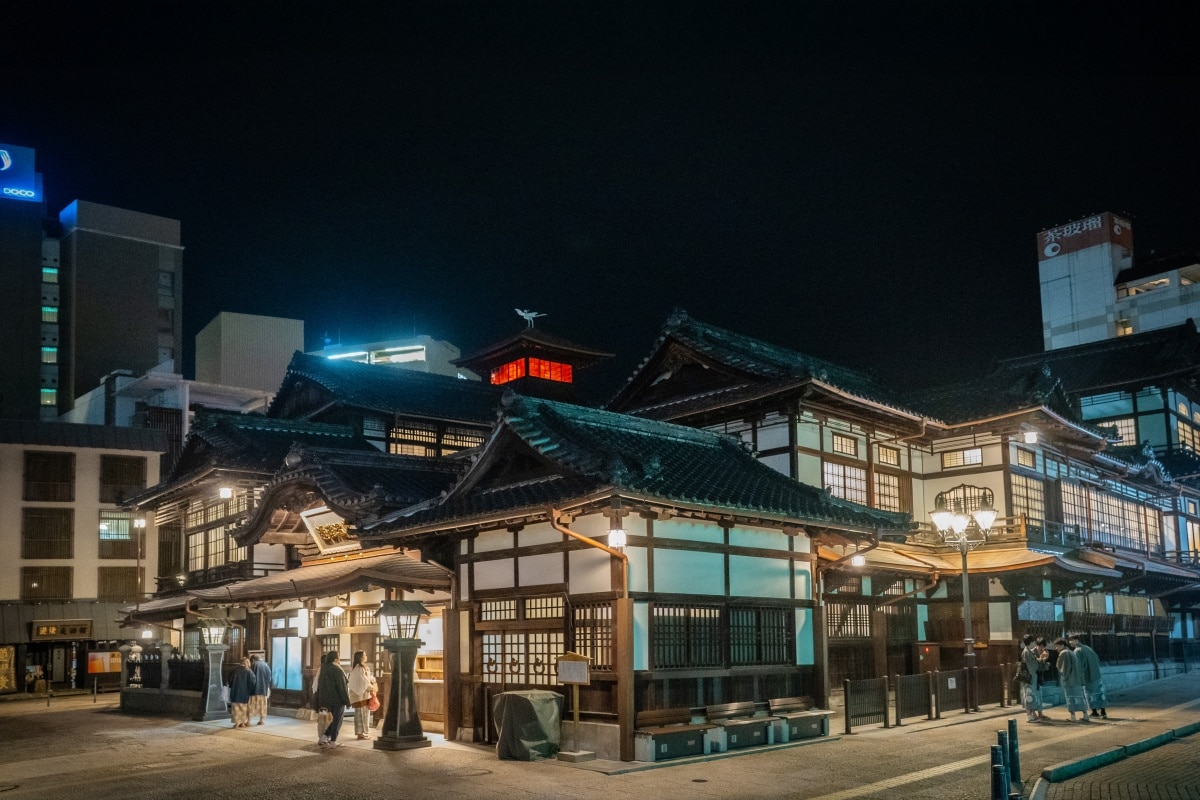
The painstakingly restored Dogo Onsen Honkan. The egret on the roof refers to the legend of the discovery of the hot springs.
Dogo’s other claim to fame is equally cryptic. I had heard about a connection to Botchan, a tale by the renowned Meiji-era author Natsume Soseki, and one of the first Japanese novels I ever read. In the novel, the young protagonist, Botchan, is recently posted to a backwater town, where he takes the liberty in a quiet bathhouse to swim in the giant tub. On his next visit, he is met by a new sign on the wall that reads, “Botchan oyogubekarazu!” (Young master, do not swim here!).
The novel does not specifically name Matsuyama or Dogo, and only mentions Shikoku as the location of Botchan’s middle school posting. In fact, the first draft placed the story in an entirely different region entirely. But Soseki did briefly teach at a middle school in Matsuyama, and that’s enough for many to believe in the Dogo setting for the bathing episode. Today, a weathered sign with the message to the young master still hangs on a wall in a prominent spot overlooking the bathers, installed through the efforts of local Soseki enthusiasts.
While the Honkan does not have private baths, for those who might be reluctant to try communal bathing, nearby Asuka-no-yu does have packages that include a private bath. Some tourists ask if tattoos are acceptable—they are.
Trams, Trains, and Iconic Shopping Streets
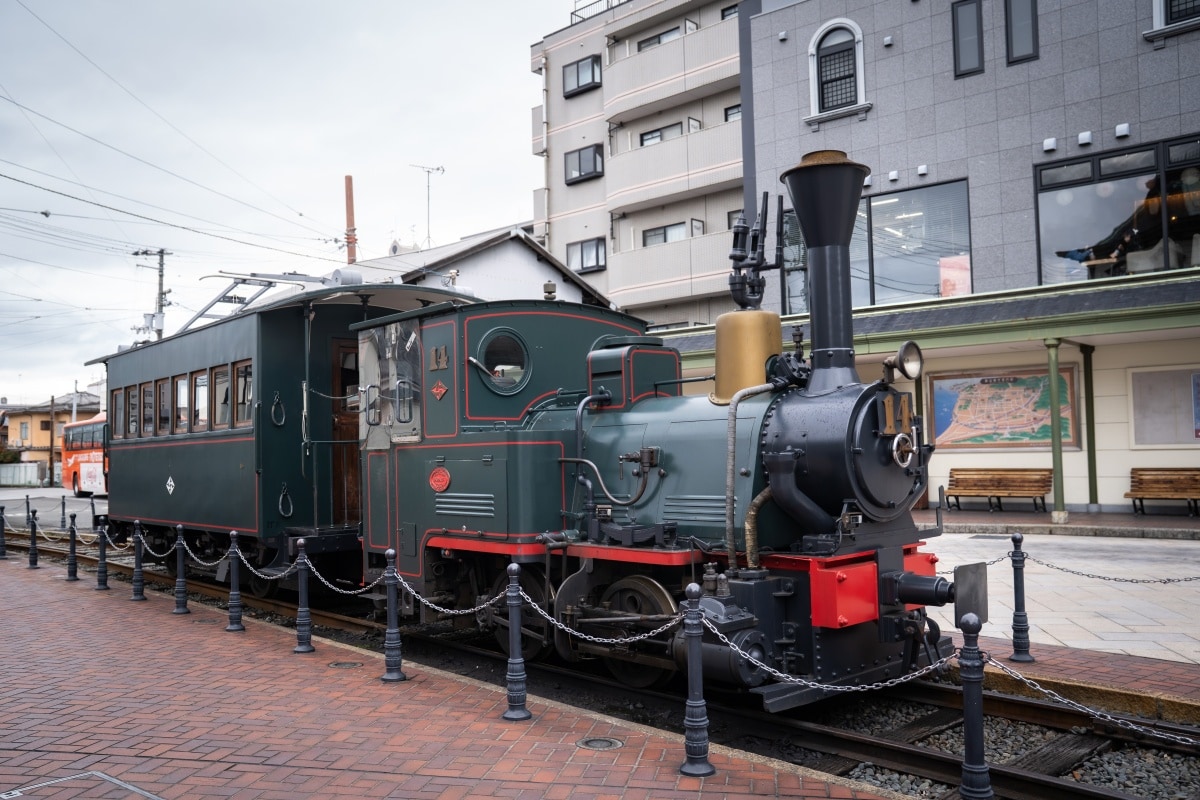
“Match-box” carriage of an old steam streetcar, the Botchan Train, which runs on weekends
Even after leaving the baths, I see Botchan references everywhere. In the novel, Botchan enjoys dango dumplings, presumed to be the three-colored dango made by the charming old Japanese sweets shop Utsuboya, in the shopping precinct immediately adjacent to Dogo Onsen. The Dogo Onsen station on the tram line that runs through Matsuyama is a charming restoration of a 1911 building. Botchan also describes a train with “match-box” carriages, and sure enough there is a Botchan Train, old steam streetcars that run four times a day on weekends and holidays. Seating is limited.
Nearby, keep an eye out for the Botchan Karakuri (Mechanical Puppet) Clock, which puts on a musical show featuring characters from Botchan every hour, on the hour, from 8:00 a.m. to 10:00 p.m. and every 30 minutes on weekends, holidays, in peak tourist seasons. There is also a free footbath next to the clock.

Dogo Haikara Dori, the buzzing shopping street near the hotsprings, has an awesome array of eateries and souvenir shops.
Matsuyama’s commercial heart is Matsuyama City Station, the hub of the local rail and tram network. I enjoy meandering through old shopping areas, so I started at Mitsukoshi department store, passing through the quaint covered shopping streets Okaido and Gintengai to Matsuchika Town, Shikoku’s only underground shopping mall (and the busiest of the three).
It was late afternoon by the time I reached Matsuchika Town. I stopped in at a standing bar, sharing space with a couple of solo patrons, for some last-minute Ehime sake paired with oden, a popular hotpot of fishcakes and vegetables. The dashi broth is the key component in good oden, and Matsuyama folk are obviously fussy about oden.
I took the tram to the spanking new JR station, completed in 2024. Faced with tempting eateries and souvenirs, I succumbed. I climbed on my bus, loaded down with some mildly sweet Dogo Onsen Beer Curry, Botchan dango (of course) and a towel featuring the local mascot Mican, a dog with a mandarin for a head, proving I’m still a sucker for Japanese kawaii goods.



